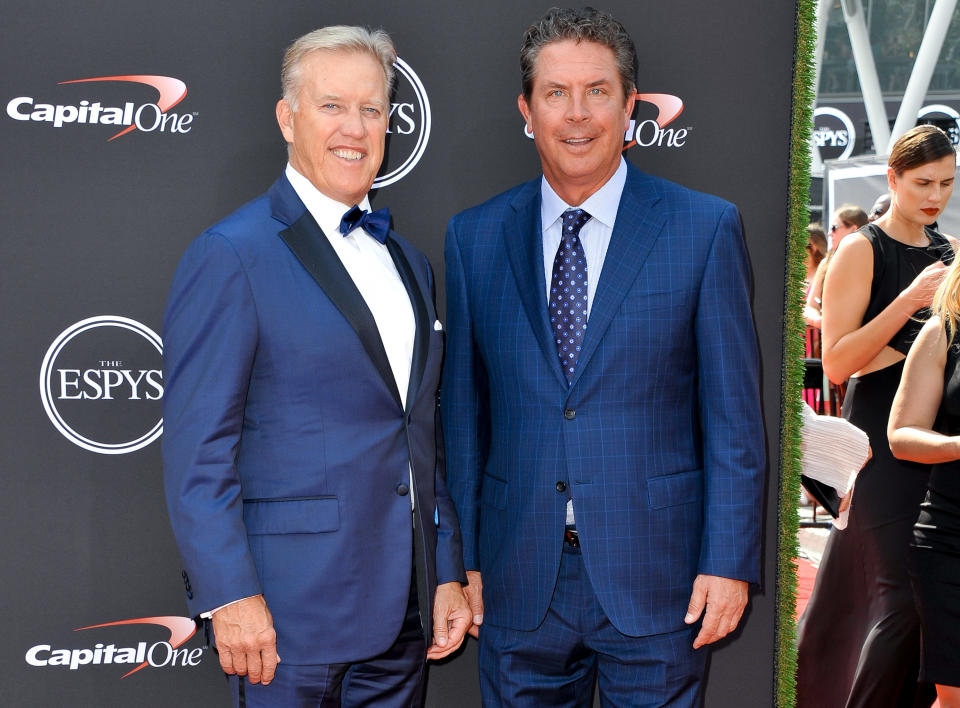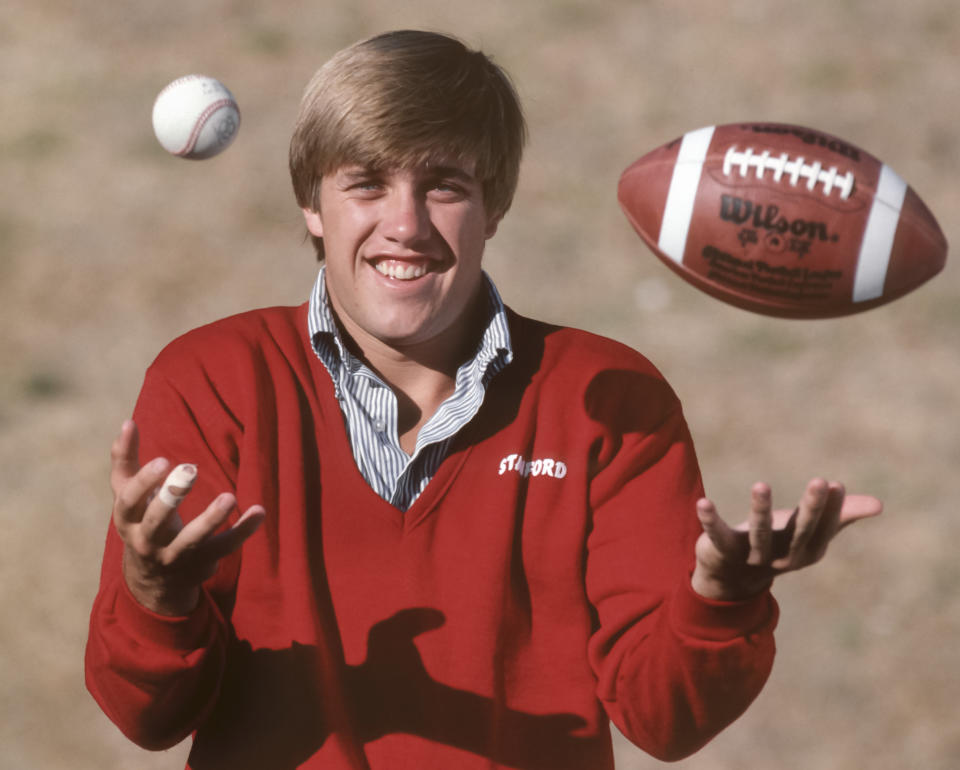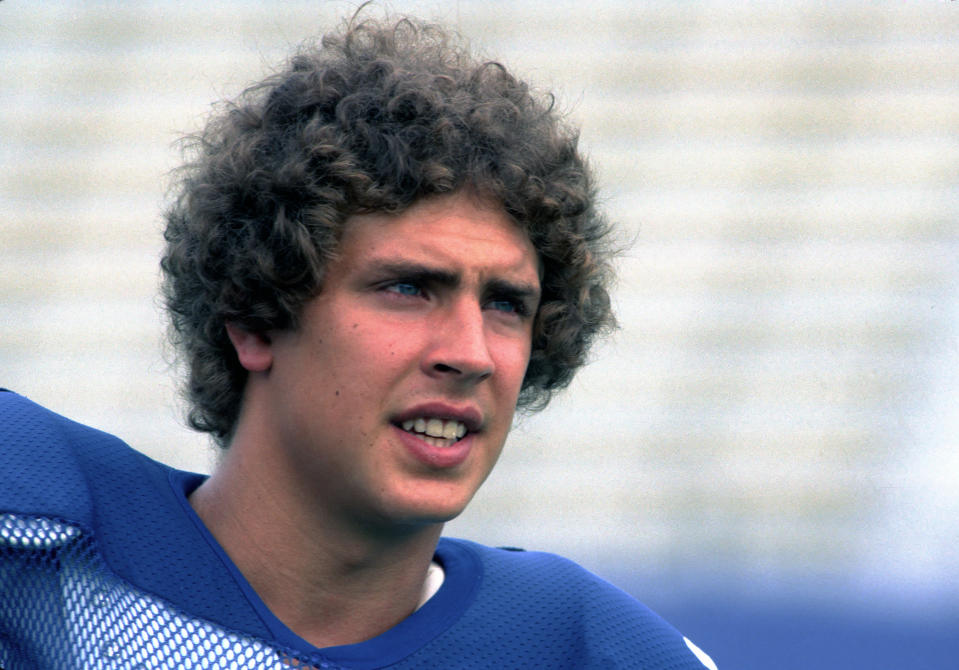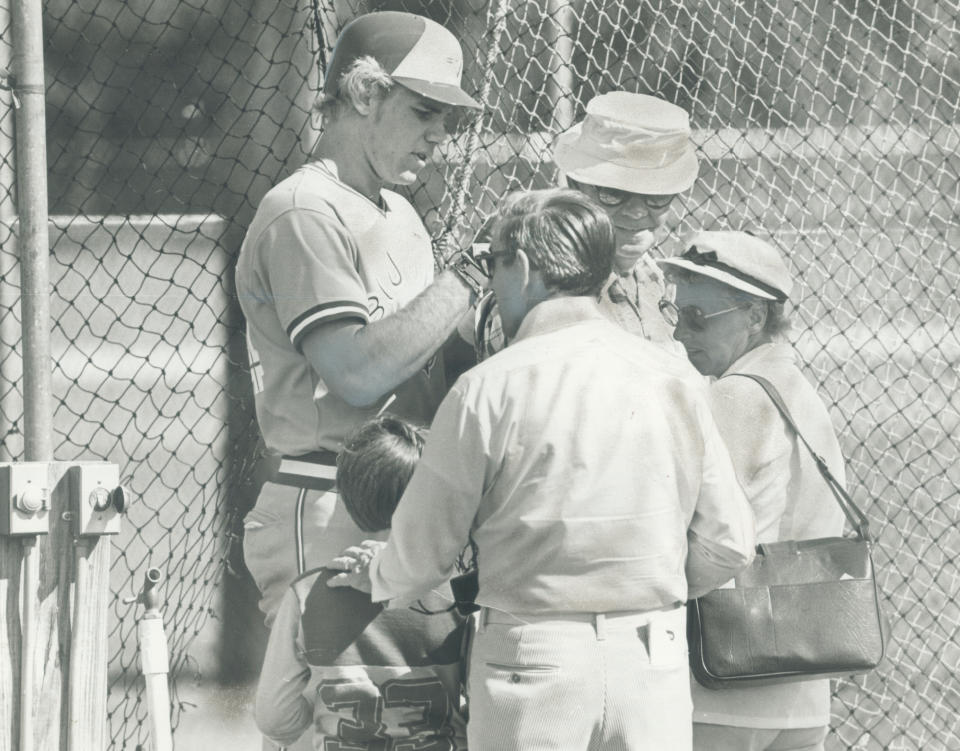The Kansas City Royals drafted these 2 Hall of Fame quarterbacks 41 years ago

No NFL team in history has selected two future Hall of Fame quarterbacks in the same draft class. But a Major League Baseball team has.
In the late 1970s, the Kansas City Royals were a brewing juggernaut and in the midst of what would be the best decade of the expansion franchise’s existence since joining MLB 10 years earlier. The Royals went from also-ran to perennial contender after striking gold throughout baseball’s amateur draft, culling pillars such as George Brett, Dennis Leonard, Willie Wilson and many others earlier in the decade.
By 1979, future Royals general manager John Schuerholz — who was inducted into the Baseball Hall of Fame in 2017 — had been elevated from director of scouting and player development to vice president of player personnel. He helped shape the Royals’ successful scouting methods that led to a championship a few years down the line.
The Royals’ draft credo was to select as many great athletes, with an emphasis on multi-sport high-school stars before that was a widespread approach. It was a highly successful tactic that led to the Royals making the playoffs seven times in 10 years starting in 1976 and winning the World Series in 1985.
So in the three-day 1979 baseball draft — which began 41 years ago Friday — it should have been no shock that the progressive franchise spent fourth- and 18th-round picks on high school quarterbacks who also happened to be terrific baseball prospects.
The stunner? Those picks turned out to be Dan Marino and John Elway.
Their NFL careers paralleled for nearly two decades as two of the very best quarterbacks of their generation. But before that, their tie runs deeper. There even was a possibility for Elway and Marino to be teammates in baseball, perhaps even battling for the same position had their careers gone a different way.
Elway was ‘a definite prospect’ in baseball
Elway’s baseball journey is usually told through the prism of the 1983 NFL draft. When it became clear that the then-Baltimore Colts were prepared to select Stanford’s quarterback with the No. 1 overall pick, Elway and his father concocted a plan to switch sports to baseball.
Elway had been a second-round pick of the New York Yankees in 1981 when he was a star outfielder for the Cardinal, leading the team with 41 RBIs that year. The following summer, he played at short-season Class A Oneonta, batting a team-high .318, with four home runs, 25 RBIs and an OPS of .896 in 42 games.
It’s less commonly known that the Royals drafted him first. Schuerholz knew the chances of signing Elway were slim, given that he had signed to play quarterback at Stanford, telling Sports Illustrated in 2017 that the Royals knew Elway’s “athletic persona was most wrapped up in a football uniform, but we thought we’d try.”
Schuerholz wasn’t dismayed when Archie Manning — a Royals third-rounder in 1971 — chose football years earlier, nor would he later be talked out of drafting another two-sport superstar, Bo Jackson, in 1986. Schuerholz also drafted Steve Bartkowski, future Atlanta Falcons QB, in the 33rd round the same year as Manning.

The Royals selected Elway in Round 18 of the 44-round draft, with the 463rd overall pick. (The Yankees, for what it’s worth, picked a first baseman from Evansville, Indiana, named Don Mattingly 30 selections after Elway. And 23 picks before Elway, the Los Angeles Dodgers selected Orel Hershiser.)
The Royals were willing to take a chance on Elway, the shortstop and pitcher from Granada Hills (Calif.) High School who led his team to the Los Angeles city baseball title in 1979, beating Crenshaw High School, led by Darryl Strawberry, who ended up being the No. 1 overall pick in baseball in 1980.
Elway also had batted .551 and .491 his final two high school seasons and was named Los Angeles Player of the Year as a senior. The Royals envisioned Elway moving to third base, with Royals scout Art Stewart telling SI, “We liked his bat, he had a strong arm, he had good hands — he was a definite prospect.”
The decision to play college football — as decorated a quarterback as he was, being named to three different All-America teams — wasn’t simple. A 1979 UPI story even indicated that scouts said Elway was a better baseball prospect than he was a football prospect.
Of course, we know how history went. Even with Elway’s baseball flirtation, his football draft rights were traded to the Denver Broncos, for whom he won back-to-back Super Bowl titles to close out a legendary career.
Marino’s baseball ceiling ‘was higher than Elway’s’
Three time zones east of Elway was another shortstop-pitcher and quarterback legend in the making. Marino was a full-fledged star in both sports at Central Catholic, but his football prowess made him the latest star to come up in western Pennsylvania. It was not only Marino’s golden arm that drew college recruiters from all over to watch the All-America selection play, but also — surprising now — his legs.
“I don't know if people realize the way he could run,” Rich Erdelyi, Marino’s football coach his junior and senior years, told the Pittsburgh Post-Gazette in 2013. He ran the 40 in 4.7 seconds. He was probably the biggest kid on the team and he could run that way. … He was just a terrific athlete.”
Injuries at Pitt and later in the NFL robbed Marino of his running ability. He became the singular statuesque pocket passer of the 1980s, even if others such as Joe Montana had more team success.
“I think Marino’s ceiling was higher than Elway’s,” Stewart told SI. “Elway would have been a solid major-league player if he’d signed out of high school. Marino was farther along. He had a chance of being an All-Star.”
Marino’s high school coach said the Royals envisioned the 6-foot-4 Marino as a center fielder, even though Schuerholz told The Guardian in 2017 that Marino would be a third baseman. Interestingly, when Marino was drafted 99th overall in Round 4, he was listed as a pitcher after going 22-0 as a starter his senior year at Central Catholic.

And the Royals made Marino an enticing offer to switch to baseball and forgo the commitment to play football at Pitt he’d made to coach Jackie Sherrill four months earlier. It was one Marino seriously mulled, according to reports. Ultimately, Schuerholz couldn’t convince Marino and his father to renege.
“I had a number of conversations with Marino’s dad,” Schuerholz told SI. “He was quite open-minded. Dan really loved baseball, but these were the days when if you signed any contract you were disqualified from playing all college sports [in the Big East].”
Stewart even told SI that “Marino wanted to play baseball” if he also could play QB at Pitt, but rules at the time prevented it.
“We were upset,” Stewart said. “We felt bad. He was a great baseball talent. We felt that he was going be a good big leaguer. Nobody will ever know.”
At Pitt, Marino became a star. The Royals even tracked his progress and attended his games, hoping to catch a falling star in case Marino had a change of heart.
Lou Lamanna, Marino’s high school teammate and freshman roommate at Pitt, told the Post-Gazette: “I will tell you that during our freshman year at Pitt, there weren't too many days he didn't spend in our room swinging a baseball bat. He’d put a dip in his mouth and act like there was a pitcher on the mound.”
But it wasn’t to be. He stuck with football, and along with Elway went on to be a first-round pick in the famous 1983 NFL draft. It became arguably the best QB draft ever, along with Jim Kelly and Ken O’Brien, and Marino and Elway ended up in the Pro Football Hall of Fame following their brilliant careers.
The what-if questions with baseball remain fascinating. Could we have had an Elway-Marino-Bo Jackson lineup in Kansas City? We’ll never know.
The year of the football draft in baseball
Marino and Elway weren’t the only two baseball products in the 1979 draft who ended up having NFL success. Former Seattle Seahawks running back Curt Warner was picked two slots behind No. 1 selection Elway in 1983 and also had been selected in the 32nd round of the 1979 baseball draft by the Philadelphia Phillies.
Also picked that year were future Washington Redskins QB Jay Schroeder (No. 3 overall, Toronto Blue Jays), NFL first-rounder Jack “The Throwin’ Samoan” Thompson (Round 34, Seattle Mariners) and Tampa Bay Buccaneers receiver Kevin House (Round 27, St. Louis Cardinals).

There were other notable football connections in the 1979 baseball draft.
Former Michigan QB Rick Leach, who finished third in the 1978 Heisman Trophy balloting, was drafted by the Tigers in the first round and went on to a major league career.
Scott Lindquist, a third-round pick of the Cincinnati Reds in 1979, was also picked in the 12th round of the 1983 NFL draft by the Oakland Raiders, although he never played in an NFL game.
On the flip side, Jeff Groth, a 33rd-round pick of the Atlanta Braves in 1979, was an eighth-round pick of the Miami Dolphins that same year and lasted seven years in the NFL as a wide receiver.
Elway’s Stanford teammate, Mike Dotterer, also played both sports in college for the Cardinal. After passing on baseball as an 18th-round pick of the Yankees in 1979, was an eighth-round pick in 1983 by the Oakland Raiders but never played a regular-season game for them.
And the only three 1979 baseball draftees who played significantly in both sports were Elway, Schroeder and John Leister, a 20th-round pick of the New York Mets who pitched for the Boston Red Sox and also was a former all-Big Ten QB at Michigan State who spent time on the Pittsburgh Steelers’s roster in 1983 and in the USFL.
More from Yahoo Sports:

